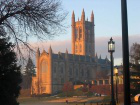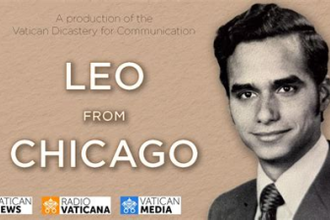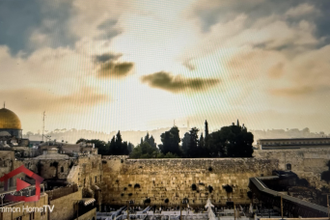USA: Latino migrants boost Catholic population

Trinity College Chapel, Hartford, Conn
The growth in the Latino population in the United States from 1990 to 2008 has helped the Catholic Church maintain its position as the nation's largest religious tradition, a new study by researchers at Trinity College, Hartford, Connectecut shows.
Over the 18-year period, the influx of nine million Latino Catholics accounted for most of the 11 million additions to the US Catholic population and, as a result, Latinos comprised 32 percent of all US Catholics in 2008 compared to 20 percent in 1990.
Even so, the Catholic Church still lost ground, albeit proportionally, among the 31 million US Latino adults as their identification with Catholicism decreased from 66 percent in 1990 to 60 percent in 2008.
Similar to the general American public, Latinos have become less identified with Christianity - down from 91 percent in 1990 to 82 percent in 2008. But other religions and faiths have failed to attract Latinos.
Mirroring the overall national trend, there has been a significant jump in the number and percentage of Nones, the no-religion population. Nones increased fourfold among Latinos from 900,000 or 6 percent in 1990 to nearly 4 million or 12 percent in 2008, making it the fastest growing segment. Religious traditions that tripled their number of adherents in the past 18 years were Protestant Sects, such as Jehovah's Witnesses and Adventists, and the non-denominational Christian Generic tradition. During that same time, the number of Pentecostal adherents doubled but merely kept pace with Latino population growth.
These findings and more are revealed in a new report, US Latino Religious Identification 1990-2008: Growth, Diversity & Transformation, which also sheds light on significant religious trends among Latinos by age, geography, education, gender, marital status, language and political affiliation. The study, which is an outgrowth of the American Religious Identification Survey (ARIS) 2008, was conducted by Juhem Navarro-Rivera, a research fellow at Trinity's Institute for the Study of Secularism in Society and Culture (ISSSC), and Trinity Professors Barry A Kosmin and Ariela Keysar.
Navarro-Rivera observed: "Over the past 18 years, there are probably few phenomena that have changed America and American religion more than the growth of the Latino population. The adult Latino population doubled from 14.6 million to 30.8 million to become the largest US minority. This immense growth of more than 16 million people has inevitably had a major impact on the religious profile and trends at both the national and state levels."
ARIS 2008 is the third in a series of landmark studies analyzing the religious beliefs and patterns of Americans in the 48 contiguous states. The earlier studies were conducted in 1990 and 2001.
Other highlights of the study:
* The longer a Latino has lived in the United States, the less likely that he or she will be Catholic. Moreover, those most proficient in English are less likely to identify themselves as Catholic and more likely to self-identify as a None or affiliate with conservative Christian traditions.
* Latino religious identification shows a gender effect, as in the general US population. Two traditions at opposite poles of the religious spectrum exhibit the largest gender imbalance: the None population is heavily male (61 percent) while the Pentecostal is heavily female (58 percent).
* Marital status reveals distinct patterns. The percentage of unmarried persons cohabitating with a partner and therefore outside of civil or religious marriage varies from 15 percent among the Nones to 11 percent among Catholics to 7 percent among non-Catholic Christians. In addition, Latinos who claim to be separated are overwhelmingly Catholic women, suggesting that Latinas are more loyal to Catholic Church prohibitions against divorce and remarriage than Latino men.
* There are over 1.1 million married male Latino Nones but fewer than 400,000 married female Nones, suggesting that many couples and many Latino homes are not religiously homogeneous.
* Considerable age differences exist between adherents of the various religious traditions, with the larger proportions of Nones and Protestant Sects under age 30.
These are the fastest growing traditions among Latinos.
* Class differences are also in evidence. The most educated major group is the Nones (25 percent possessing a college degree), while the least educated is the Protestant sects (8 percent who are college educated). Mainline Protestant Latinos have the highest household incomes and sectarian Protestants the lowest. Meanwhile, the non-denominational Christian Generic tradition is the most suburbanized.
* Latino political party preference and voter registration varies by religious tradition. The study reveals that Latino Catholics and Nones are most likely to prefer the Democratic Party, while Republican Party preferences are more common among the non-Catholic Christian traditions.
Keysar suggests: "distinct Latino religious communities and profiles are emerging in different parts of the country which reflect differences in socio-demographics and country of origin."
* The most striking geographical change is the shift of the Christian Generic tradition towards the South, almost tripling its Latino population in the region. In Texas, Latinos grew from 8 percent in 1990 to 20 percent in 2008 of those in the Christian Generic tradition. The percentage of Latinos among Catholics in Texas dropped from 73 percent to 66 percent over the 18-year period, while Latino Nones rose from 15 percent to 28 percent of all Texans without a religious identification.
* Latinos went from being 51 percent of all Catholics in California in 1990 to 56 percent in 2008, while Latino Nones in that state climbed from 10 percent to 24 percent of all Californian Nones.
* The proportion (though not the number) of Nones has dropped among Latinos in New York. However, Protestant Sects tradition, such as Seventh Day Adventists and Jehovah's Witnesses, gained ground in New York and in Florida to become one-tenth of the Latino population in these states.
Kosmin stated that "whereas Latino immigrants are contributing significantly to the stability of American Catholicism, the younger generation and the US-born population are tending to polarize between those moving away from religion and those moving towards conservative Christian traditions."
In sum, the report shows that Latinos are undergoing a transformation by becoming more religiously diverse even as they are transforming the American religious landscape.
To download a copy of US Latino Religious Identification 1990-2008: Growth, Diversity & Transformation, see: www.americanreligionsurvey-aris.org/latinos2008.pdf.















